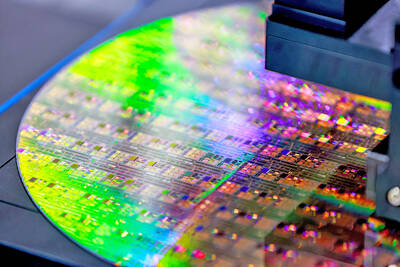A Japanese company that got its start making grinding wheels for machinery more than 80 years ago believes that it holds the key to helping manufacturers create ever slimmer and more powerful semiconductors to power next-generation mobile phones and advanced computers.
Disco Corp’s machines can grind a silicon wafer down to a near-transparent thinness and cut the tip of a hair into 35 sections.
That know-how would allow chipmakers to stack integrated circuits on top of each other in a process called 3D packaging, promising smaller chip footprints, reduced power consumption and higher bandwidth between various parts.
“Imagine having to cut a croissant cleanly in half,” Disco chief executive officer Kazuma Sekiya said in an interview. “That takes a special kind of knife and considerable craftsmanship.”
The semiconductor industry has long relied on Moore’s Law as a model for chip-technology breakthroughs, but makers are now approaching the physical limits of their ability to cram more transistors onto silicon as leaders like Taiwan Semiconductor Manufacturing Co (TSMC, 台積電) migrate to ever-smaller nodes such as 3 nanometers.
That is prompting manufacturers to turn to solutions like 3D packaging to provide an edge.
Disco’s technology has been in the making for four to five years and is finally ready for practical use, Sekiya said.
The small number of specialized machines Disco has already shipped have had very high gross margins, Sekiya said, without providing details.
Dicers are typically used toward the end of the fabrication process to cut individual chips from a wafer.
Slicing more chips earlier in the process, where per-unit prices are higher, would result in a boost for Disco’s revenue, he added, declining to give a specific timeline.
Some memory chips and image sensors — devices that convert light into ones and zeros — already make use of vertical integration.
TSMC has said that it would spend about one-10th of its US$30 billion capital expenditure budget this year on advanced packaging and masking technologies.
Sekiya’s grandfather founded the company in 1937 to cash in on demand for grinding equipment amid Japan’s pre-World War II military buildup.
After the war, Disco’s abrasive wheels found use in grinding magnets for electricity meters and slitting fountain pen nibs. In 1974, it was tasked by the University of Tokyo with the job of cutting a moon rock brought back by the Apollo 11 mission.
It opened its US office in 1969, a year after Intel Corp was founded and at the very dawn of the microchip revolution. Disco is now one of a number of little-known Japanese companies that are indispensable to semiconductor production. It controls 81 percent of the market for grinders and 73 percent for dicers in semiconductors, Nomura Securities Co data showed.
As COVID-19 infections at the firm stayed low, totaling in single digits in Japan, almost 90 percent of its staff are back in the workplace, Sekiya said.
Disco employs about 5,600 people.
The company ran its factories at full capacity for the past year amid a flood of orders from chip manufacturers racing to boost supplies in a global chip shortage. Disco’s revenue grew 30 percent last fiscal year to ¥182.9 billion (US$1.66 billion), while profit jumped almost 46 percent to ¥53.1 billion.
Sekiya said that there are still no signs of slack in demand, and Disco is shopping for land in Hiroshima and Nagano prefectures to expand its factories.
“This momentum will definitely continue through the fiscal first half,” he said. “There are zero signs of a slowdown right now.”

Taiwan’s rapidly aging population is fueling a sharp increase in homes occupied solely by elderly people, a trend that is reshaping the nation’s housing market and social fabric, real-estate brokers said yesterday. About 850,000 residences were occupied by elderly people in the first quarter, including 655,000 that housed only one resident, the Ministry of the Interior said. The figures have nearly doubled from a decade earlier, Great Home Realty Co (大家房屋) said, as people aged 65 and older now make up 20.8 percent of the population. “The so-called silver tsunami represents more than just a demographic shift — it could fundamentally redefine the

The US government on Wednesday sanctioned more than two dozen companies in China, Turkey and the United Arab Emirates, including offshoots of a US chip firm, accusing the businesses of providing illicit support to Iran’s military or proxies. The US Department of Commerce included two subsidiaries of US-based chip distributor Arrow Electronics Inc (艾睿電子) on its so-called entity list published on the federal register for facilitating purchases by Iran’s proxies of US tech. Arrow spokesman John Hourigan said that the subsidiaries have been operating in full compliance with US export control regulations and his company is discussing with the US Bureau of

Businesses across the global semiconductor supply chain are bracing themselves for disruptions from an escalating trade war, after China imposed curbs on rare earth mineral exports and the US responded with additional tariffs and restrictions on software sales to the Asian nation. China’s restrictions, the most targeted move yet to limit supplies of rare earth materials, represent the first major attempt by Beijing to exercise long-arm jurisdiction over foreign companies to target the semiconductor industry, threatening to stall the chips powering the artificial intelligence (AI) boom. They prompted US President Donald Trump on Friday to announce that he would impose an additional

China Airlines Ltd (CAL, 中華航空) said it expects peak season effects in the fourth quarter to continue to boost demand for passenger flights and cargo services, after reporting its second-highest-ever September sales on Monday. The carrier said it posted NT$15.88 billion (US$517 million) in consolidated sales last month, trailing only September last year’s NT$16.01 billion. Last month, CAL generated NT$8.77 billion from its passenger flights and NT$5.37 billion from cargo services, it said. In the first nine months of this year, the carrier posted NT$154.93 billion in cumulative sales, up 2.62 percent from a year earlier, marking the second-highest level for the January-September